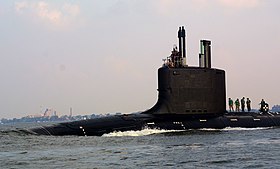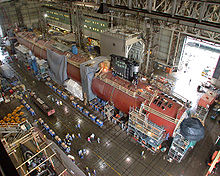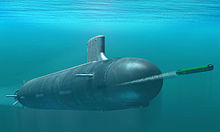Virginia class (submarine)
 Virginia during test drives off Portsmouth, Va |
|
| Overview | |
|---|---|
| Type | Hunting submarine |
| units | 17 in service, up to 30 planned |
| Namesake | US state of Virginia |
| period of service |
since 2005 |
| Technical specifications | |
| displacement |
7925 tons submerged |
| length |
115 m |
| width |
10.4 m |
| Draft |
9.5 m |
| Diving depth | 800 ft, corresponds to approx. 244 m |
| crew |
14 officers, 120 men |
| drive |
An S9G reactor, nozzle ring propeller |
| speed |
25+ knots |
| Armament |
4 torpedo tubes, 12 vertical missile launch tubes |
The Virginia-class is a class of nuclear-powered fighter submarines of the United States Navy . It was planned in the 1990s and has been built since 1999. Up to 30 units of this class are planned to form the backbone of the American submarine fleet in the 21st century.
history
Planning and construction
The Virginia class was planned in the NSSN ( New Attack Submarine ) program as a replacement for the early boats of the Los Angeles class , after only three units could be financed by the Seawolf class and new operational concepts were necessary due to the end of the Cold War were. This made the Virginia class the first submarine class that could be developed specifically to cater to the changed conditions of the new geopolitical situation. After the Navy deviated from their numbering with the Seawolfs to show that these will be the submarines for the 21st century (hence SSN-21 to -23), the Virginias will re-enter the order and from SSN- Classified 774.
Construction will be carried out at the Electric Boat (EB) and Newport News Shipbuilding (NNS) shipyards . EB builds large parts of the hull as well as engine rooms and the control center, while NNS manufactures the bow, stern, tower and torpedo rooms, among other things . The individual modules are later joined together and launched into the water. The Navy selected EB as the building yard, but the orders are split 50:50 between the two shipbuilding companies. The construction of the class is currently on schedule. The third unit was delivered on time, the fifth unit was supposed to be ready six months before the agreed time. In December 2007, however, it became known that NNS workers had used various brazing alloys for continuous welds to weld pipe systems in the non-nuclear part of the submarines, contrary to the specifications of the Navy . This caused delays in the fourth unit. The further program was not delayed by this, however, the fifth unit was actually handed over to the Navy around eight months ahead of schedule in summer 2008, which enabled savings of around 54 million US dollars to be achieved.
Originally, the class was also planned as a lower-cost alternative to the $ 2 billion Seawolf . Savings should be achieved, above all in computerization and networking, through extensive standardization of components ( Open System Architecture ). However, an industrial arrangement (a kind of agreement between the shipyards and the Navy) was necessary to keep Electric Boat and Newport News Shipbuilding alive. Among other things, this results in costs of up to 2.6 billion dollars per boat. By resorting to more modern, easier-to-install equipment and the use of improved construction processes, the costs of later units should fall to $ 4 billion at the rate of 2005 for two units per year.
The first four units were commissioned together in 1998, another in August 2003 and five in January 2004. In January 2005 it was announced that the program, which has a total budget of 81.3 billion dollars, was due to the budget deficit in the USA should be shortened. The Navy placed eight further orders in December 2008, the last of these boats will be delivered according to plan in 2019. Starting in 2011, the program was increased to a rate of two boats per year in order to be able to maintain a hunting submarine fleet of 48 units in the long term
Modifications
The boats are delivered in three modification stages, so-called flights . Among other things, consideration is being given to building a section amidships that can be easily exchanged and thus adapted to the mission of a trip. This could for example concern different weapon configurations or a hangar for small underwater vehicles. On the fifth and sixth boats, the Advanced Sail was also to be tested, a streamlined tower which, in addition to better diving properties, also increases the enclosed space within the tower, in which a small hangar can also be integrated. However, this was postponed to later boats , the Advanced Sail will not be used until 2014 [obsolete] . With the Transformational Technology Core , a new core is to be developed for the reactor and installed on later boats that delivers 30 to 50 percent more energy.
In Flight III boats, the twelve vertical launch tubes are replaced by two revolver magazines with six launch tubes each. These magazines are a modified version of the devices used on Ohio-class boats that have been converted to SSGN . This measure is intended to reduce the acquisition and maintenance costs. A new sonar should also ensure lower costs and better performance. The new system will also use components from the Seawolf-class sonar . The Flight III configuration will be introduced with the eleventh boat, which is to be delivered around 2015 [obsolete] .
The Flight V boats are equipped with six Virginia Payload Tubes (VPT) . This VLS can hold up to 40 cruise missiles. The installation of the six VPT increases the length of the boats to 140.2 m and the displacement increases to 10,200 tons.
Present and Future
On October 23, 2004, the first unit, the USS Virginia and on September 4, 2006 the successor unit, the USS Texas entered service. Further commissioning took place in 2007, 2008 (2 units), 2010 (2 units), 2011 and 2012. In the same year, the launch of the USS Minnesota took place , which was put into service in September 2013 (11 months ahead of schedule). The USS North Dakota has been under construction since 2012 and has been in service since October 2014. So far, 18 boats have been approved, the dates for the start of construction of the other units are not yet known. The Navy hopes 30 units can be shipped by 2020.
By 2020, the number of active Los Angeles boats will have dropped below 25, so the Virginia class should provide the majority of the fleet's fighter submarines. With a service period of 30 years or more, the class is expected to last until the middle of the 21st century.
technology
hull
The hull of the Virginia class is 115 meters long, which is a little longer than the hulls of the two previous classes. The width is 10.4 meters. When submerged, a boat displaces around 8,000 tons. This puts it above the Los Angeles class, but in line with the plan to build a smaller boat, it is well below the Seawolf class .
Within the fuselage, the individual compartments are cushioned to minimize noise. The down rudders are attached directly to the pressure hull at the bow; the front ones are retractable while the rear ones, located directly in front of the drive, are fixed. The control is not, as in earlier classes, via a control horn , but via a sidestick , which transmits the commands electrically to the rudders, similar to modern aircraft.
The entire hull is covered with an anechoic layer, which should make it difficult to detect the boats by sonar. At the beginning there were difficulties with this shift. On the first three boats 5 to 7% of the tiles peeled off, on later boats only less than 2%.
drive
The drive consists of a pressurized water reactor of the type S9G ( S for submarine , 9 for the ninth generation of nuclear reactors for submarines, G for the manufacturer, General Electric ). This brings an output of almost 30,000 kW (40,000 hp) via two turbines to a single shaft that drives a nozzle ring propeller. The advantage of this technology, which was used for the first time in the British Trafalgar class in submarines, is above all a reduction in the noise emitted by the drive and a faster response when changing speed. The speed the boats can actually reach is a secret, but the Navy speaks of "25+ knots". Observers, however, assume a top speed of over 30 knots, as the Virginia class should be on a similar level to the Seawolf class due to the nozzle ring propeller and the optimized hull design .
Armament
The Virginias are equipped with four torpedo tubes with a diameter of 21 inches (533 millimeters) from which, in addition to the standard torpedo Mark 48 ADCAP , encapsulated cruise missiles of the type UGM-109 Tomahawk or the UGM-84 Sub Harpoon can be shot; in addition, sea mines can be laid. Each boat has a vertical launching system with 12 vertically arranged tubes from which cruise missiles of the Tomahawk family can also be launched. Inside the submarine there is space for 24 spare weapons for the torpedo tubes, the VLS cannot be reloaded en route.
As of Flight III, the twelve vertical launch tubes (VLS) were equipped with two revolver magazines with six launch tubes ( Virginia Payload Tubes (VPT) ) each. These magazines are a modified version of the devices used on Ohio-class boats that have been converted to SSGN. This measure is intended to reduce the acquisition and maintenance costs. The first submarine of this flight, the USS North Dakota (SSN-784) , entered service on October 25, 2014. A new sonar system is also installed from this flight.
The Virginia class is equipped with electronic baits that can be released from 14 mounts mounted on the hull in the event of an enemy torpedo attack in order to deflect the weapon from the boat by imitating a submarine noise pattern (passive) or by creating sound-impermeable air bubbles (active). In addition to the brackets, there is also a rechargeable hatch for the discharge of deceptive substances.
electronics
The most important locating instrument of the Virginia class is its low-frequency spherical sonar in the bow, which can both emit sound waves in order to listen to the echo of other ships ( active ) and ( passive ) to their screw noises, e.g. through cavitation . In addition, depending on the situation, the boats can deploy one of two towing sonars , towed passive sonar sensor chains. The sensors are located up to a kilometer behind the boat, which reduces the falsification of the sonar image caused by its own operating noises. Several passive sensors ( Lightweight Wide Aperture Array from Northrop Grumman Electronic Systems ) based on fiber optic sensors are attached to the sides of the case , not ceramic as in older systems. There is also an active high-frequency sonar on the tower and on the “chin”, ie under the spherical sonar on the outside of the shell, which is used to detect small objects such as mines. The data is processed by the BQQ-10 (V4) sonar processing system .
For navigation when not submerged one exists at the tower radar type BPS-16 by Litton Marine Systems , which on the I-band , working, so 8-10 GHz. Several antennas are available for communication, including high-frequency antennas for satellite communication and extremely low-frequency antennas, which can be used to receive short code groups even at great depths.
The Virginia class boats no longer have a conventional optical periscope , but two BVS-1 optronic masts , which contain high-performance cameras with infrared sensors and image intensifiers . The antennas for electronic warfare ( EW: electronic warfare ) are integrated in the masts, as is a laser-based range finder. The advantage of the system used is that the mast no longer has to be guided through the pressure envelope into the command center, as the data obtained is transmitted to the submarine's control center via optical fibers .
Mission profile
The Virginia class boats have been designed for a wide range of missions. In addition to the classic combat missions against surface and underwater ships and against land targets and as a sonar outpost for aircraft carrier combat groups or similar groups, the class has also been developed for littoral warfare (German: coastal warfare). This includes sonar computers that offer the clearest possible results even in the difficult water conditions in shallow water, where unusual convergence zones and thermoclines can appear, among other things . For this purpose, the boats can start and control unmanned underwater vehicles , i.e. drones for underwater use, in order to scout out waters that are too shallow for the boat itself or to locate minefields. At the same time, electronic reconnaissance can be carried out via the EW mast, and there is also a pressure lock that divers can use to leave and re-enter the boat for covert operations, for example .
Web links
- Virginia class on the sides of the CNO (English)
- Virginia class on globalsecurity.org (English)
- Virginia class on naval-technology.com (English)
Footnotes
- ↑ a b c Undersea Warefare : More for Less ( Memento of November 2, 2007 in the Internet Archive ), Capt. Dave Johnson, USN and Lt. jg Dustin Muniz, USNR (English)
- ↑ http://www.navytimes.com/news/2007/12/navy_faulty_shipwelds_071214w/ (link not available)
- ↑ New Hampshire christened as newest attack sub ( Memento from September 3, 2012 in the web archive archive.today ) (English)
- ↑ cq.com: Rumsfeld's Strategy For 'Transformation' , (English; Page 12; PDF; 1.1 MB)
- ↑ Navy Force Structure and Shipbuilding Plans (English; The Congressional Research Service explains the Navy's blueprint until 2037; PDF; 1.4 MB)
- ↑ Navy.mil: Navy Awards Block V Virginia-Class Submarine Contract
- ^ Maritime-Executive.com: US Navy Orders New Block of Attack Submarines
- ↑ Official fact sheet on navy.mil (English)






